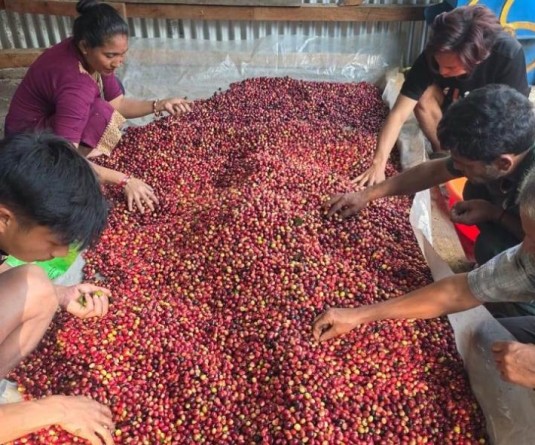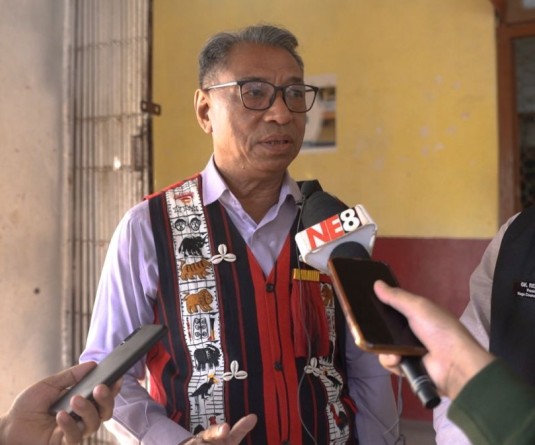
Longrangty Longchar
Dimapur | June 30
With virtually no irrigation facility and with shortage of water, the once-lush paddy fields in Nuiland areas especially around Showuba villages are nothing but baked earth and grasses. The peasants, mostly “Muslim migrants from Assam” who cultivate fields for a daily wage of about Rs 90 per day, are helpless except to look to the sky. They work on the parched fields that otherwise were overgrown with rich paddies a year ago.
The Indian Metrological department has predicted that the states of Nagaland and Meghalaya would receive short rainfall this year, and the monsoon in Dimapur is still being awaited by the people, more so by farmers.
“Last year the crops were this high,” said Harkhul Islam, indicating that the crops were knee-high. However, he now works in the field with his spade with the hope that the rain gods would smile on him. He works on, he says, as the season is passing and that he might have to hurry if the rain arrives. Besides, he has nothing to do other than to construct drains which would channel water once the rain arrives.
A woman laborer who works on a field for a sum of Rs 80 a day said the water drained from nearby rivers is not enough to irrigate the fields. “Unless there is water from the sky, all the crops would die,” said the peasant woman who refused to divulge her name. But she did say that she has two children and that her husband is a beggar. She even said that the water drained from the river is not enough as other farmers have blocked it and that there is not enough water for the fields.
The same story goes on for the other farmers. Even the nursery for paddy plantation in the fields is getting withered. Razak Ali, another peasant said that they are working slowly in the fields in the vain hope that it would rain. He has still 70 percent of the fields to be ploughed as the bullocks cannot easily plough hard baked earth. The nursery for paddy which has sprouted about four inches in the cracked earth is turning yellow and is being withered. Other grain seeds are yet to sprout and they will not until they are watered, from above.
“It’s everything to god now, whether the rain will come or not,” said Razak Ali, who stared at the dark sky overhead longing for rains, but only to be replied with a drizzle and the humid air. While these peasants in the fields owned by Naga landlords might never have heard about the Indian Metrological department’s prediction, the state Agriculture department is gearing up to face any eventuality. However, the Agriculture department is also praying for the monsoon to lash the area and water the parched land.
The Director of Agriculture, Dr Supong Keitzar, when queried about the delayed monsoon and its affect on agriculture, agreed that the rainfall is scanty and a bit delayed in the state. He however said that there is no need to worry as yet. He informed that districts like Mokokchung have not been affected as the rainfall received was sufficient for jhum cultivations. Still, he said that agriculture in Mon and Tuensang districts has been affected about 40-50 percent.
But, it is the paddy fields in the low-lying areas that are the worst-affected as these areas are not receiving enough rain this year. Dr Keitzar however gave two or three weeks time, roughly till the fortnight of August, until the state can be declared a drought-hit state like Manipur, if the monsoon rains fails to arrive. Manipur government recently declared the state as drought-hit. For now there is no need for ‘worry.’ It is just a time to wait for the rains for a few more weeks.
Nonetheless, Dr Keitzar asserted that Nagaland’s department of Agriculture is discussing some contingency plans if there is delayed rainfall in the state. He said that the department is planning to pay some ‘compensation’ like distribution of ‘short duration crop’ and also winter crops to affected farmers.
Rains are usually heavy in Nagaland. The average rainfall is between 175cm and 250 cm. Most of the heavy rainfall is during the 4 months from June to September.
However, this year, the Indian Metrological Department (IMD) during its report from May 25 and June 19, 2009 about the current monsoon season informed that the state of Meghalaya has recorded the highest deficit of rainfall at 75 per cent, while Nagaland received 60 per cent less than the normal rainfall during this period.
And though, many citizens in Dimapur, especially senior citizens, say that the scarcity of rainfall is a strange phenomenon since at this time most of the city remains flooded with inundated rain waters. The monsoon winds are yet to make its presence in the city. As for the peasants working in the paddy fields, their prayer is simply for the rain gods to smile on them.






